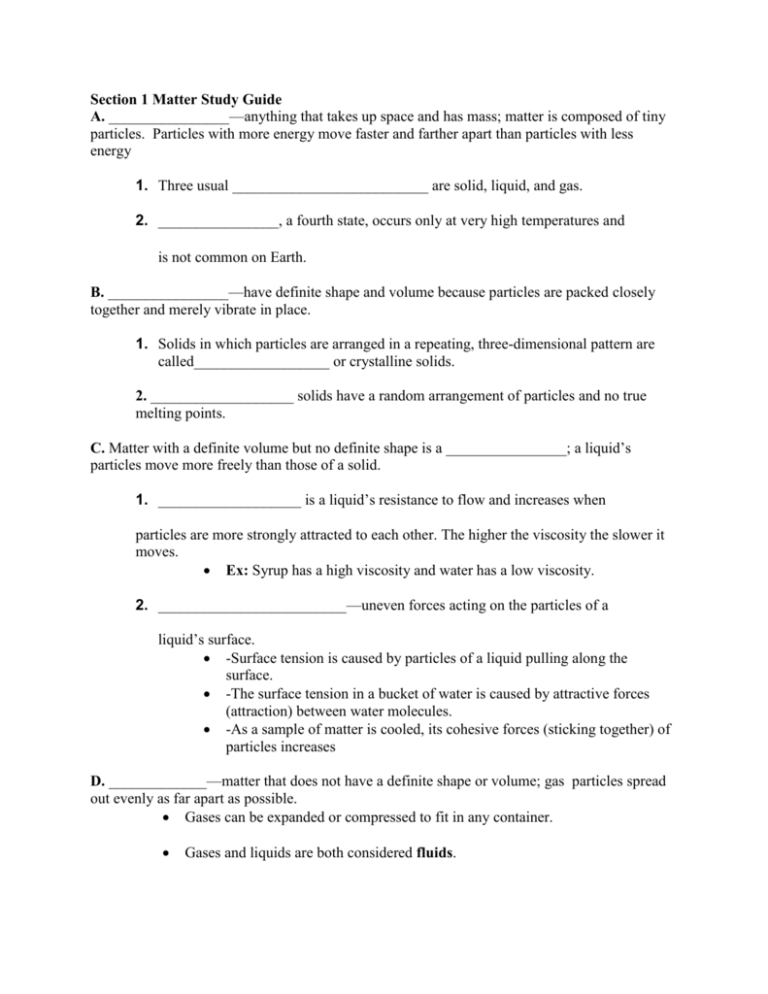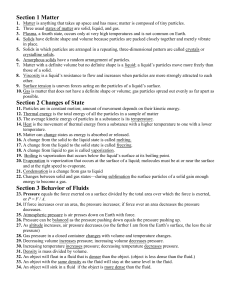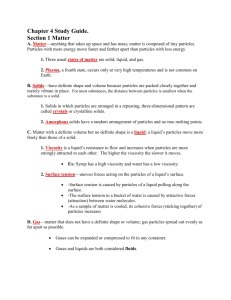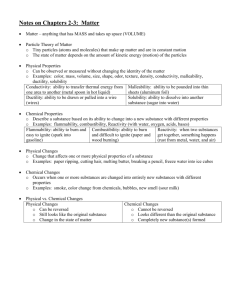Chapter 4 Study Guide
advertisement

Section 1 Matter Study Guide A. ________________—anything that takes up space and has mass; matter is composed of tiny particles. Particles with more energy move faster and farther apart than particles with less energy 1. Three usual __________________________ are solid, liquid, and gas. 2. ________________, a fourth state, occurs only at very high temperatures and is not common on Earth. B. ________________—have definite shape and volume because particles are packed closely together and merely vibrate in place. 1. Solids in which particles are arranged in a repeating, three-dimensional pattern are called__________________ or crystalline solids. 2. ___________________ solids have a random arrangement of particles and no true melting points. C. Matter with a definite volume but no definite shape is a ________________; a liquid’s particles move more freely than those of a solid. 1. ___________________ is a liquid’s resistance to flow and increases when particles are more strongly attracted to each other. The higher the viscosity the slower it moves. Ex: Syrup has a high viscosity and water has a low viscosity. 2. _________________________—uneven forces acting on the particles of a liquid’s surface. -Surface tension is caused by particles of a liquid pulling along the surface. -The surface tension in a bucket of water is caused by attractive forces (attraction) between water molecules. -As a sample of matter is cooled, its cohesive forces (sticking together) of particles increases D. _____________—matter that does not have a definite shape or volume; gas particles spread out evenly as far apart as possible. Gases can be expanded or compressed to fit in any container. Gases and liquids are both considered fluids. Section 2 Changes of State Study Guide A. Particles are in constant motion; amount of movement depends on their ________________________. -Energy is the ability to do work or cause change. Kinetic energy is the energy of motion. 1. ________________________—total energy of all the particles in a sample of Matter A warmer substance has more thermal energy than a cooler one. 2. The average kinetic energy of particles in a substance is its _____________________. 3. ______________—movement of thermal energy from a substance with a higher temperature to one with a lower temperature Heat moves in or out of a substance during a change of state B. _______________________—amount of heat needed to raise the temperature of 1 g of a substance 1° C A substance with a high specific heat takes more heat to raise its temperature one degree Celsius. C. Matter can ________________ states as energy is absorbed or released. 1. A change from the solid to the liquid state is called _________________. When a material is melting, the temperature remains the same 2. A change from the liquid to the solid state is called __________________. The melting point of a substance is the same as its freezing point. D. Changes between ________________________ states 1. 1. A change from liquid to gas is called ______________________. The rate of evaporation of a liquid decreases as the temperature decreases. a. _________________ is vaporization that occurs below the liquid’s surface at its boiling point. b. _____________________ is vaporization that occurs at the surface of a liquid; molecules must be at or near the surface and at the right speed to evaporate. 2. ______________________—a change from gas to liquid E. Changes from a solid directly to a gas state is called sublimation —during _____________________ the surface particles of a solid gain enough energy to become a gas. Section 3 Behavior of Fluids Study Guide A. Pressure is the force exerted on an area. __________________ equals the force exerted on a surface divided by the total area over which the force is exerted, or P = F / A. The newton is a unit of force. 1. If force ___________________ over an area, the pressure increases; if force over an area___________________, the pressure decreases. 2. ______________________________—air presses down on Earth with force. Atmospheric pressure is 101.3kilopascals. For a straw to work, the atmospheric pressure pushes down on the liquid's surface 3. Pressure can be __________________ as the pressure pushing down equals the pressure pushing up. 4. As __________________ increases, air pressure decreases. B. Gas pressure in a closed container _________________ with volume and temperature changes. 1. Decreasing volume ___________________ pressure; increasing volume ___________________ pressure. Increasing temperature increases pressure; decreasing temperature decreases pressure. Tires on a bicycle heat up as they are ridden causing the pressure to increase inside the tire. If a container of gas gets larger while the temperature remains the same, the pressure decreases. 2. Increasing temperature ___________________ pressure; decreasing temperature___________________ pressure. Meeting Individual Needs Continue on next page. C. _______________________—an upward force on an object immersed in a fluid. The force of the liquid pushing up an object is caused by buoyant force. An object is able to float on water if it less dense than the water. 1. _______________________________—buoyant force on an object is equal to the weight of the fluid displaced by the object. 2. ________________ is mass divided by volume. a. An object will _______________ in a fluid that is denser than the object. Because lead has a lower density than liquid mercury, it will float in mercury. b. An object with the same density as the fluid will stay at the ______________ level in the fluid. c. An object will ______________ in a fluid that is less dense than the object. D. ____________________________—when a force is applied to a confined fluid, an increase in pressure is transmitted equally to all parts of the fluid. Pascal's Principle can be applied to any matter that can flow. 1. ___________________________—allow people to lift heavy objects with relatively little force. 2. When squeezed, liquids will be pushed out of a ____________________, a closed container with a hole in it.











